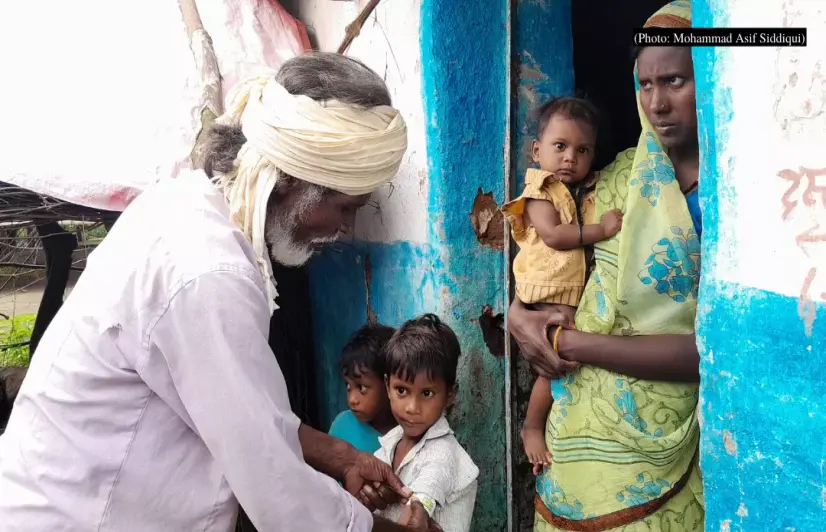Traditional healers preach, practice change among Korku tribals in Madhya Pradesh

Traditional healers preach, practice change among Korku tribals in Madhya Pradesh
The community members in Khalwa block now visit hospitals for treatment, thanks to padiyars and bhumkas who constantly monitor their nutritional and health conditions
Khandwa, Madhya Pradesh: Padiyar Bisram Kende is sharp as a tack when he examines his ‘patients’. “See this child, I have been monitoring his health for a long time now,” he tells, while explaining how bad the boy’s condition was earlier. The same family had another severely malnourished child, but Kende’s timely intervention ensured that the child returned to normal life.
Explaining his method of work, Kende says, “Nowadays, I do not wait for people to come to me. Whenever I hear of a home where a child is weak or frequently ill, I advice the family to move the patient to a hospital. I dispense my folk medicine only when a cure is possible.”
Padiyars (folk healers) and bhumkas (tribal priests) are now a quintessential part in promotion of modern medicine among the Korkus. Their influence on the tribal community in Madhya Pradesh remains unquestioned as people always consult them to get a cure for any disease troubling them.
Rajaram, who runs a flour mill in Indirakheda, has been doing padiyari for the last five years. Every day some patient comes to him for treatment. When needed, they send the patient to the hospital (Photo: Mohammad Asif Siddiqui)
Earlier, they would perform religio-magical rites and dismiss most ailments as a case of external spirits attacking the mortal body. But not anymore, thanks to the SABAL project, a joint venture launched in 2018 by Caritas India and Khandwa Diocesan Social Services, which devised a plan to counter superstitions and dogmas hindering community health.
Reaching out to 95 padiyars and 30 bhumkas in 30 villages, Caritas India made them understand how their practices were having a deleterious effect on the community, already reeling under malnutrition and poverty. Once they agreed to join hands, they were imparted training to detect diseases.
Padiyar Rajaram of Indirakheda doing padiyari outside his house. He is treating a patient who has come to him (Photo: Mohammad Asif Siddiqui)
Magic of MUAC tapes
Khalwa block in Khandwa district of Madhya Pradesh has 147 villages under 86 gram panchayats. The programme is operational in 30 villages with a total population of 36,133. Every village has a bhumka, and one or more padiyars.
The 30 villages that are part of the project altogether have six sub-primary health centres, which handle vaccinations and dispense medicines. Seriously ill patients are sent to Khalwa or Khandwa for treatment.
According to SABAL project coordinator Rakesh Karole, a survey conducted by them in 2018 found 82 severely malnourished and 215 moderately malnourished children in these villages. Soon, padiyars and bhumkas wer
Take the case of Devlikala, a remote village in Khalwa block with 85% tribal population. Whenever they attend to a sick child, Padiyar Kende, Munshi Kaliram and Bhumka Sakharam Onkar first assess the nutritional status by fixing the band on the left upper arm. If the child turns out to be undernourished or malnourished, they immediately 'prescribe' hospitalisation.
Long ago, padiyars and bhumkas were knowledgeable enough to provide relief to malnutrition using folk medicine. With each passing generation, the knowledge base declined and religio-magical practices took its spot, compounding the sufferings of the sick. Distressingly, healers started to brand malnourished children and tribals in pain with a hot iron. Even three months ago, on June 10, branding marks were found on two tribal children who sought treatment in Khandwa district hospital.
Bhumka Sakharam of Devlikala says if a sick child or person comes to me for treatment, we make arrangements to take them to the hospital. Padiar Munshi Kaliram also supports him in this work (Photo: Mohammad Asif Siddiqui)
Guiding lights
“If a villager approaches me with a sick child, I immediately inform SABAL workers, who arrange a vehicle to transport the patient to the hospital,” says Onkar, who is helped by Kaliram.
Ever since traditional healers became part of the programme, tribals have started visiting hospitals. In the past, if health workers attempted to admit a malnourished child, the tribals would vanish into the forests fearing they would never return alive once they entered the hospital. Besides, they were not interested in long hospital stays, especially in malnourishment cases that involve 21 days of treatment.
According to Robin George, programme lead, Caritas India, padiyars and bhumkas were initially reluctant to be part of the project as villagers always looked up to them for free healing and advice. “They feared it would jeopardise their position in society. It took a lot of convincing to change their mindset.”
Bisram, Sakharam and Munshi of Devlikala leave the house several times together to find malnourished and sick children and take them to the hospital (Photo: Mohammad Asif Siddiqui)
Kende of Devlikala succeeded his father Bhadar Kende as a padiyar. “I used to help my father with his work. After his death, I became the padiyar as per tradition. That was 35 years ago. I have a large family, and 1.5 acres of rain-fed farmland. The household runs on the yield from the farm, and gifts and donations I get from people in my position as a padiyar.”
Like Kende, Indirakheda’s Rajaram Rama carries forward the family legacy of padiyar while running a flour mill in the village. Onkar is also into farming, though he has been the bhumka of Devlikala for a decade. “I have one acre of rain-fed farmland. After harvesting the kharif crop, I migrate for work and treat people using herbal medicines and exorcism.”
Edited by Rina Mukherji
Cover image: Bisram is measuring malnutrition levels of a child with the MUAC tape.
Would you like to Support us
101 Stories Around The Web
Explore All NewsAbout the Reporter
Write For 101Reporters
Would you like to Support us
Follow Us On
.png)



